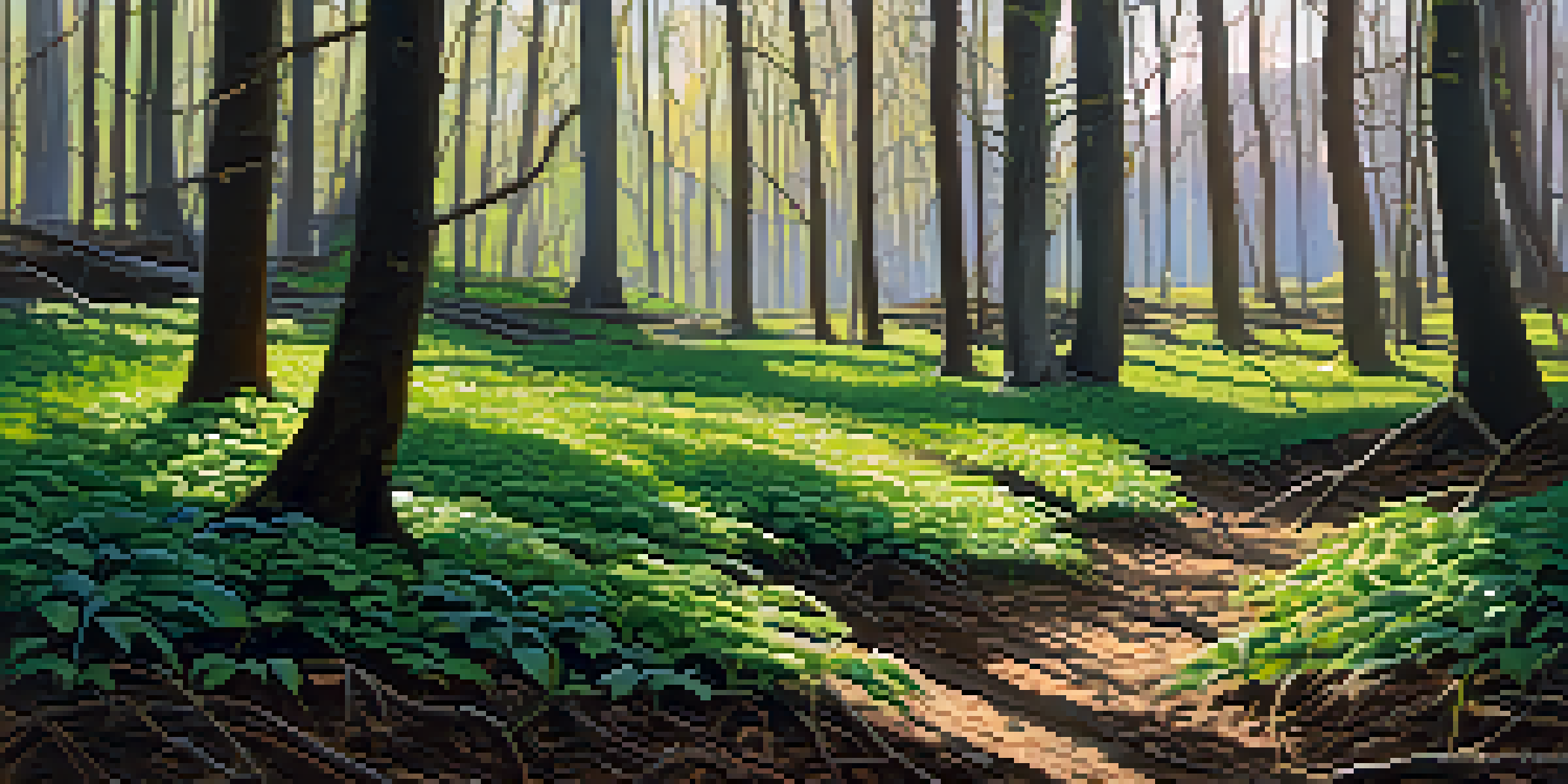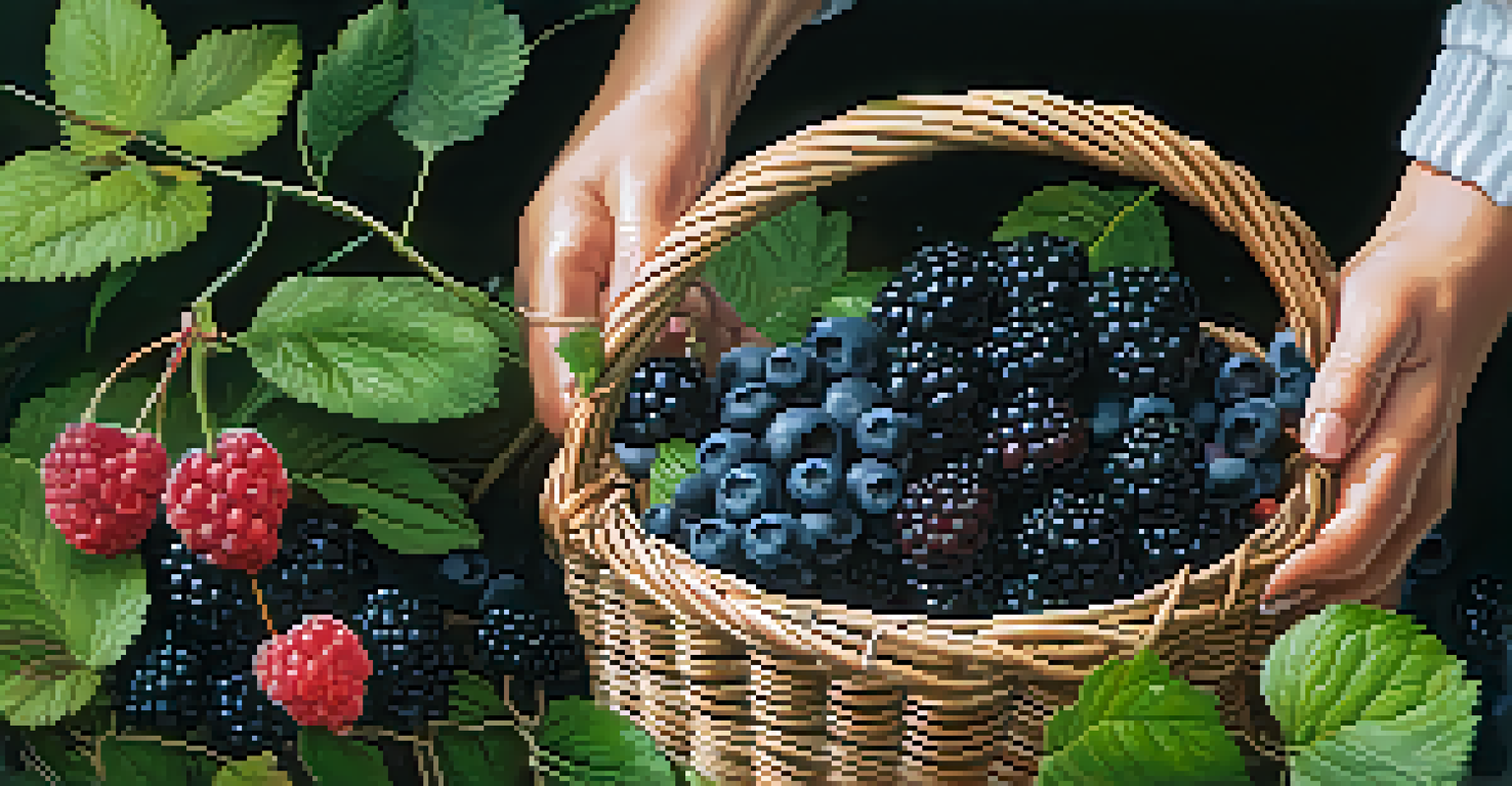Key Principles for Sustainable Foraging of Wild Edibles

Understanding Sustainable Foraging Practices
Sustainable foraging is all about gathering wild edibles without harming the environment. It means taking only what you need and ensuring that the ecosystem remains intact for future generations. Just like a well-tended garden, our natural landscapes thrive when we respect their boundaries and allow them to regenerate.
The earth does not belong to us; we belong to the earth.
Imagine walking through a forest and seeing an abundance of wild berries. Instead of picking every single one, you might take just enough for a pie, leaving plenty for wildlife and for future foragers. This practice not only protects the plants but also supports the biodiversity of the area.
Ultimately, sustainable foraging is about balance. By being mindful of how much we take and the impact it has on the surrounding environment, we can enjoy nature’s bounty while preserving it for others.
Know Your Local Ecosystem
Before heading out to forage, it's essential to familiarize yourself with your local ecosystem. Each area has its unique plants, seasons, and regulations that dictate what can be harvested and when. Think of it as getting to know a new friend; understanding their habits and preferences will help you interact positively.

Take time to research local flora and fauna, understanding which species are abundant and which are threatened. This knowledge helps you make informed decisions about what to forage and ensures that you’re not inadvertently harming a vulnerable population.
Sustainable Foraging Benefits Nature
Practicing sustainable foraging helps maintain the ecosystem by only taking what you need, ensuring that wild plants can continue to thrive.
Additionally, each ecosystem plays a vital role in the environment. By respecting and understanding these systems, you contribute to their health while enjoying the fruits of your labor.
Harvesting with Care and Respect
When foraging, it’s important to harvest with care and respect for the plants. This means using techniques that minimize damage, such as cutting leaves or stems instead of uprooting entire plants. Imagine trimming a hedge rather than ripping it out; this approach allows the plant to continue growing.
In every walk with nature one receives far more than he seeks.
By adhering to ethical harvesting practices, you not only preserve the plant for future growth but also maintain the integrity of its habitat. Every small action counts in the grand scheme of environmental conservation!
Remember, taking too much from one area can lead to depletion. Instead, practice the principle of 'leave no trace'—ensure that your foraging leaves the environment as it was when you arrived.
Seasonality and Responsible Foraging
Understanding the seasonal patterns of wild edibles is crucial for sustainable foraging. Different plants thrive at different times of the year, and knowing when to forage can prevent overharvesting. Think of it like waiting for your favorite fruit to ripen; patience pays off in the end.
For example, wild ramps are often foraged in early spring, while mushrooms may appear in late summer or fall. By aligning your foraging with the natural rhythms of the seasons, you can ensure that you’re not only harvesting responsibly but also enjoying the best flavors.
Know Your Local Ecosystem
Familiarizing yourself with your local flora and fauna is essential for making informed foraging decisions that support environmental health.
Being aware of these cycles allows you to plan foraging trips more effectively, ensuring that you engage with nature at the right times and contribute positively to the ecosystem.
Identifying Edible vs. Toxic Plants
One of the most important skills in foraging is accurately identifying edible versus toxic plants. Not all wild edibles are safe to consume, and some can be dangerously misleading. Picture a game of 'hide and seek'—you need to be sharp and attentive to spot the right plants.
Investing time in learning about common wild edibles and their toxic lookalikes can save you from potential health hazards. Guides, apps, and local foraging groups can be invaluable resources in this journey.
Always err on the side of caution; if you're unsure about a plant's edibility, it's best to leave it be. Your health and safety should always be the top priority when foraging.
Ethical Considerations in Foraging
Foraging isn't just about gathering food; it also comes with ethical responsibilities. Consider the impact your foraging has on the environment and local communities. It’s like being part of a shared family—you wouldn’t take more than your fair share from the dinner table.
Engaging with local communities can provide insight into traditional foraging methods and respect for nature. Building these relationships fosters a sense of responsibility and encourages sustainable practices.
Educate and Inspire Others
Sharing your foraging knowledge with others fosters a culture of sustainability and encourages responsible practices within the community.
Ultimately, ethical foraging is about being a good steward of the land. By respecting the communities and ecosystems you interact with, you contribute to a culture of sustainability.
Educating Others about Foraging
Part of practicing sustainable foraging is sharing your knowledge with others. Education empowers individuals to make informed decisions about foraging and encourages responsible practices. Think of it as planting seeds for a more sustainable future.
Hosting workshops or foraging tours can be fun ways to engage your community and raise awareness about the importance of respecting nature. Sharing your experiences and lessons learned can inspire others to adopt sustainable foraging habits.

As more people become educated about the benefits and responsibilities of foraging, the collective impact can lead to healthier ecosystems and a greater appreciation for our natural resources.